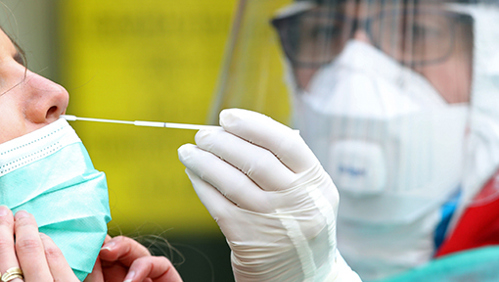
Professor Brendan Crabb and Professor Mike Toole outline the need for Australia to adopt an anti-transmission strategy to control COVID-19 in 2023, in an editorial commissioned by Nine Media.
The arrival just over a year ago of the new and different-looking Omicron variant of COVID-19 brought much hope that this would usher in the end of the pandemic.
That hope was based on two assumptions: that Omicron led to milder disease than earlier variants, and that its extraordinary capacity to spread fast would mean that the wider population would rapidly be exposed to this “milder” virus and further boost the immunity that 95 per cent of Australian adults already had through two doses of the vaccine.
And so the “hybrid-immunity” strategy was born. The idea was that we could ease off public health measures that were perceived as restricting so much of society, and let widespread infection do most of the work.
The prime minister at the time, Scott Morrison, encouraged us to “push through” the first Omicron wave, and Queensland’s chief health officer went as far as to say it was probably “necessary” for us to be infected. What followed was by far the worst public health disaster in Australia since World War II.
There are no flags at half-mast, however, for the approximately 15,000 lives lost in 2022 (compared with just over 2000 in the previous two years), no national day of mourning, little empathising at the deep daily impact COVID-19 has had on millions of more “vulnerable” Australians, little concern over what chronic COVID-19 disease might do and is doing to the wider population.
Since the election, Prime Minister Anthony Albanese and his advisers have simply said COVID-19 is no longer exceptional and should be treated like other respiratory infections. But a conservative estimate is that 500,000 Australians will suffer from long COVID, for which there is no specific treatment.
A still uncertain yet clearly major chronic disease burden will cause severe hospital and healthcare disruption and have an impact on the workforce and school attendance. The gulf between COVID reality and the narrative from our leaders could hardly be wider.
The current wave is almost as severe as any of the other three waves we faced last year, with more than 100,000 reported cases a week. While case numbers mean much less now that testing and reporting have dropped off so significantly, hospitalisation rates remain a reasonably reliable guide to the scale of the problem.
Almost 4000 people are hospitalised with COVID-19, close to the peak of 5500 in the July-August wave. Emergency departments across the country are under strain.
Why the disconnect between COVID reality and the message Australians receive from our leaders?
Almost every Australian has been infected, many two or three times, and more than 17,000 lives have been lost to the pandemic. That number grows when so-called “excess deaths” - deaths more than expected based on the average in pre-pandemic years - are calculated.
These are people who would have otherwise lived. In the blink of an eye, COVID has become one of the nation’s biggest killers, and because it is “additional”, life expectancy will start to decline, something that has not occurred for more than five decades.
There may be no reprieve in 2023. The uncontrolled spread of the virus among China’s 1.4 billion people, with their poor vaccination rates and low natural immunity, creates the perfect setting for the emergence of new variants of unknown severity.
Their arrival in Australia will be slowed by the government’s new testing measures for travellers from China, but they will reach Australia. And new variants, of course, can arise anywhere. The XBB.1.5 variant surging in the United States looks particularly concerning.
Put simply, the virus is winning. So why the disconnect between COVID reality and the message Australians receive from our leaders?
Perhaps it relates to the biggest myth of all, the freedom fallacy. This is the idea that to have an open, free society we can’t address COVID because we don’t want the “restrictions” that come with it. Equating controlling COVID to “lockdowns”, travel restrictions and school and business impositions continues to be a huge hurdle. But none of it is true.
It is much clearer now what can be done to control COVID, and it is not restrictive. Higher booster vaccination coverage, investment in clean air, judicious high-quality mask wearing and widely available and encouraged testing are the tools we have available.
The latter is especially important, not just so those who are positive know to stay away from others, but so they can get treated if they are eligible. Countries, such as Singapore, that apply these tools more effectively do better than Australia.
So, what’s next? It is our view that the most important change Australia needs to make is a strategic one. One that is explicitly anti-transmission.
But we realise that, as things stand, Australia is very unlikely to face COVID reality and to change tack. What will it take for us to see that our strategy, one that promotes infection, is wrong? A major new discovery about long COVID? Severe illness in a senior official or someone they love? A new variant of concern?
Is there anything? Or are we consigned to acceptance of this toll, to living with COVID and all its consequences no matter what? We hope not. It doesn’t need to be this way.

